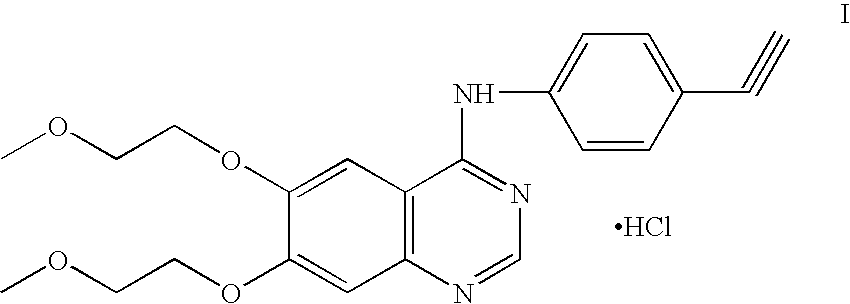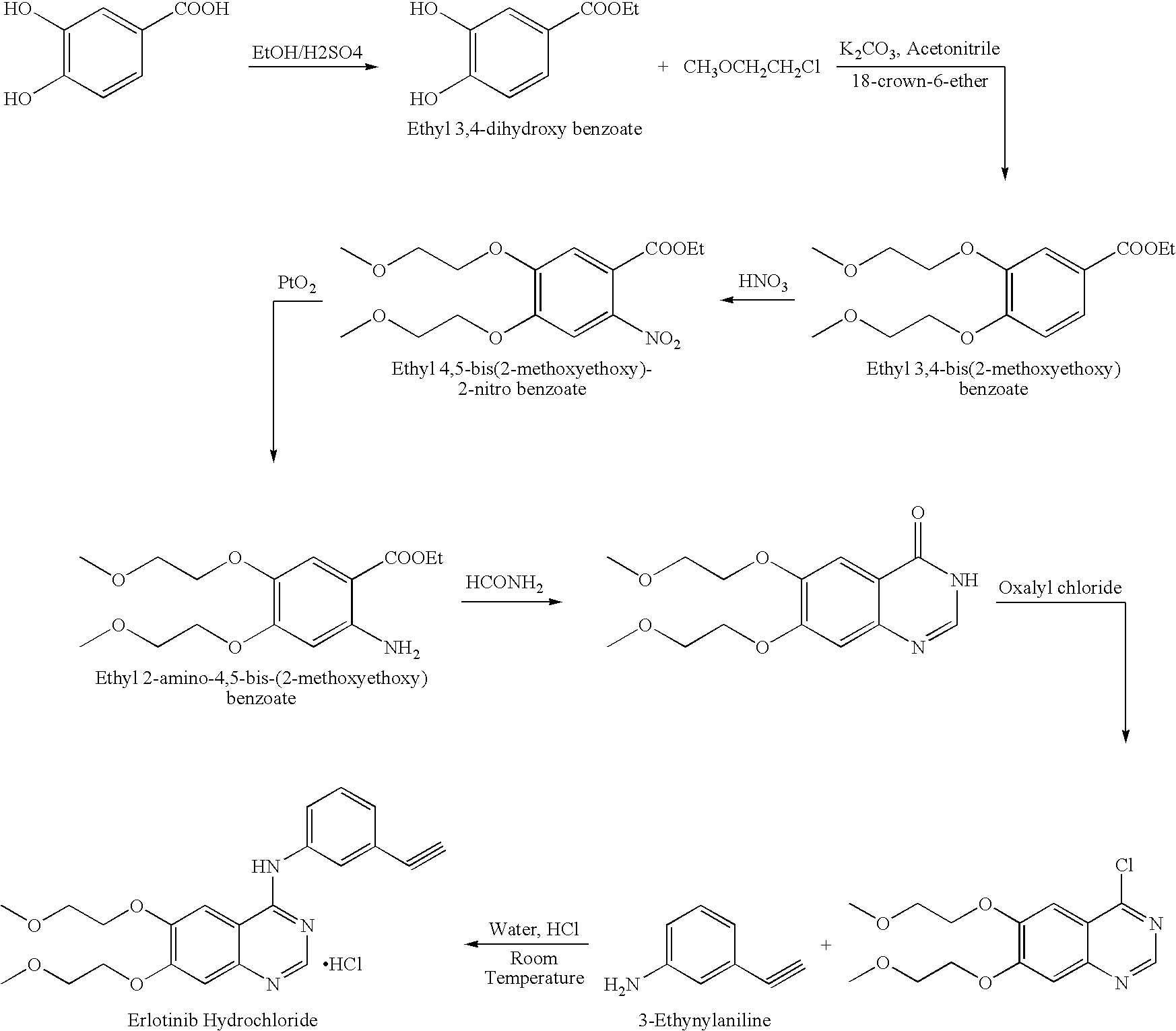Process for Preparation of Erlotinib and its Pharmaceutically Acceptable Salts
a technology of erlotinib and erlotinib, which is applied in the field of synthesis of erlotinib and its pharmaceutically acceptable salts, can solve the problems of time-consuming and cumbersome processes, and achieve the effect of simple and economical process for commercial production
- Summary
- Abstract
- Description
- Claims
- Application Information
AI Technical Summary
Benefits of technology
Problems solved by technology
Method used
Image
Examples
example-1a
Preparation of Erlotinib Hydrochloride
[0040]5.0 g of 4-chloro-6,7-bis(2-methoxyethoxy) quinazoline was suspended in 75 ml water and 2.55 g of 3-aminophenyl acetylene was charged at 25-30° C. Further 1.0 ml 50% hydrochloric acid was added. The reaction mass was stirred at 25-30° C. for 2 hours. The solid obtained was filtered and washed with water. The product was dried at 40-45° C. to obtain 6.1 g of erlotinib hydrochloride.
[0041]In a similar manner, different solvents were used for preparing erlotinib hydrochloride under acidic conditions as given in table 1 below:
TABLE 1ExampleReactionno.Solvent usedEfficiencyHPLC PurityTime1aWater88.76%99.12%2hours1bDimethyl carbonate77.50%98.50%1.5hours1cDenatured spirit87.31%99.03%½hour1dAcetonitrile91.67%97.44%½hour1eIsopropanol90.22%98.87%½hour1fAcetone90.22%98.40%½hour
example-2a
Preparation of Erlotinib Hydrochloride
[0042]5.0 g of 4-chloro-6,7-bis(2-methoxyethoxy) quinazoline was suspended in 75 ml of water and 2.55 g of 3-aminophenyl acetylene was added at 25-30° C. followed by 1.0 ml of 50% hydrochloric acid. The reaction mass was heated at 35-40° C. for 1 hour. The solid obtained was filtered and washed with water. The product was dried at 40-45° C. to obtain 5.8 g of erlotinib hydrochloride.
[0043]In a similar manner, different solvents were used for preparing erlotinib hydrochloride under acidic conditions as given in table 2 below:
TABLE 2ExampleReactionno.Solvent usedEfficiencyHPLC Puritytime2aWater85.40%99.22%1 hour2bDenatured spirit96.04%99.25%1 hour2cTetrahydrofuran93.13%98.89%1 hour2dAcetone87.31%98.81%1 hour2eAcetonitrile96.33%99.23%1 hour2fAcetonitrile +93.42%99.02%1 hourToluene2gEthyl acetate +96.04%83.74%1 hourAcetonitrile2hAcetone + water72.75%99.01%1 hour
example-3
Preparation of Erlotinib Hydrochloride
[0044]5 g of 4-chloro-6,7-bis(2-methoxyethoxy) quinazoline was suspended in 150 ml denatured spirit (SPDS) and 4.6 g of 3-aminophenyl acetylene was charged at 25-30° C. Further 1.0 ml of methane sulphonic acid was added. The reaction mass was stirred at 25-30° C. for 3 hours. Solid obtained was filtered, washed with SPDS and dried under vacuum. This solid was suspended in water, basified with ammonia and stirred for 10 minutes. The resulting erlotinib base was isolated, washed with water and dried under vacuum. The base was suspended in water and acidified to pH 1.0-2.0 using hydrochloric acid. The reaction mixture was stirred for 2 hours, filtered, washed with water and dried at 40-45° C. to obtain 5.8 g of erlotinib hydrochloride.
PUM
 Login to View More
Login to View More Abstract
Description
Claims
Application Information
 Login to View More
Login to View More - R&D
- Intellectual Property
- Life Sciences
- Materials
- Tech Scout
- Unparalleled Data Quality
- Higher Quality Content
- 60% Fewer Hallucinations
Browse by: Latest US Patents, China's latest patents, Technical Efficacy Thesaurus, Application Domain, Technology Topic, Popular Technical Reports.
© 2025 PatSnap. All rights reserved.Legal|Privacy policy|Modern Slavery Act Transparency Statement|Sitemap|About US| Contact US: help@patsnap.com


